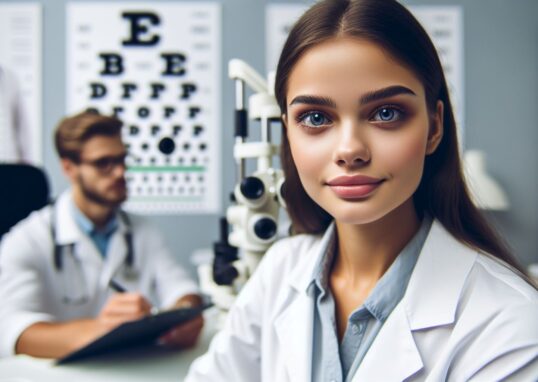
Age-Related Macular Degeneration (AMD) is a medical condition that primarily affects the central part of the retina known as the macula. The macula is responsible for sharp, detailed vision, which is essential for activities such as reading, driving, and recognizing faces. AMD is a leading cause of vision loss in older adults, and understanding the age-related aspects of this condition is crucial for early detection and management.
The Common Age for AMD
AMD typically manifests in individuals over the age of 50, earning the designation “age-related.” It is most prevalent in those 60 years and older, but the risk continues to increase with each passing decade. While the condition is rare before the age of 55, it becomes more common in people 75 years or older. This pattern suggests that aging is a significant risk factor for the development of AMD.
Let’s delve into why older individuals are more at risk for Age-Related Macular Degeneration (AMD):
- Accumulated Damage:
- Over time, the cells in the macula (the central part of the retina) accumulate wear and tear. This gradual damage affects their function, leading to AMD.
- The aging process reduces the ability of these cells to repair themselves efficiently.
- Oxidative Stress:
- As we age, our bodies become less effective at neutralizing harmful molecules called free radicals.
- These free radicals cause oxidative stress, damaging retinal cells and contributing to AMD development.
- Blood Supply Changes:
- Aging affects blood vessels, including those in the retina.
- Reduced blood flow to the macula can lead to cell dysfunction and degeneration.
- Drusen Formation:
- Drusen are yellow deposits that accumulate beneath the retina.
- Older individuals tend to develop larger and more numerous drusen, which are associated with AMD risk.
- Genetic Factors:
- Certain genetic variations increase susceptibility to AMD.
- As we age, the impact of these genetic factors becomes more pronounced.
- Immune System Changes:
- Aging weakens the immune system’s ability to regulate inflammation.
- Chronic inflammation in the retina contributes to AMD progression.
- Lifestyle and Environmental Factors:
- Long-term exposure to sunlight, smoking, and poor nutrition can exacerbate AMD risk.
- Older adults may have accumulated more exposure to these factors over time.
What about individuals under 50? Although rare, a form of macular degeneration can develop at younger ages. Here’s why:
- Juvenile Macular Degeneration (Stargardt Macular Degeneration):
- Although AMD is most commonly associated with older adults, there is a rare form called juvenile macular degeneration or Stargardt macular degeneration.
- This genetic disease affects children and young adults, causing progressive vision loss.
- Stargardt macular degeneration occurs in fewer than 1 in 10,000 children.
- Early-Onset AMD:
- While less common, some individuals under the age of 50 may experience early forms of AMD.
- Early signs may include subtle changes in central vision or blurring.
- These cases can eventually lead to the loss of visual acuity (20/20 vision) over time.
- Risk Factors and Genetics:
- Genetic factors play a significant role in early-onset AMD.
- Certain gene mutations can predispose younger individuals to macular degeneration.
- Additionally, lifestyle factors (such as smoking and diet) and systemic health conditions (like high blood pressure) can contribute to AMD risk.
Types of AMD
There are two main types of AMD: dry (atrophic) and wet (neovascular). Dry AMD is more common and is characterized by the thinning of the macula and the presence of drusen, which are yellow deposits beneath the retina. Wet AMD, though less common, is more severe and involves the growth of abnormal blood vessels under the retina, which can leak fluid and blood.
Symptoms and Progression
The symptoms of AMD vary depending on the type. Dry AMD generally leads to a gradual decline in central vision, while wet AMD can cause rapid and severe vision loss. Common symptoms include blurriness, dark or empty areas in the center of vision, and the distortion of straight lines.
AMD progresses through three stages: early, intermediate, and late. Early AMD is often asymptomatic, making regular eye exams critical for early detection. Intermediate AMD may cause some vision loss, but it is the late stage that poses the greatest threat to vision.
Risk Factors and Prevention
In addition to age, other risk factors for AMD include genetics, smoking, high blood pressure, obesity, and a diet high in saturated fats. Lifestyle changes such as quitting smoking, maintaining a healthy weight, and eating a diet rich in leafy greens and fish can help reduce the risk of AMD.
Treatment and Management
While there is no cure for late-stage dry AMD, certain vitamins and supplements may slow its progression. Wet AMD can be treated with anti-VEGF injections, laser therapy, or photodynamic therapy to slow or stop the growth of abnormal blood vessels.
The Global Impact of AMD
AMD is not only common in the United States but also has a significant global impact. It is estimated that by 2040, nearly 288 million people worldwide will be affected by AMD. This underscores the importance of global awareness and access to eye care services.
Living with AMD
Despite the challenges posed by AMD, many individuals continue to lead fulfilling lives with the help of low-vision aids, adaptive technologies, and support from healthcare professionals and organizations dedicated to those with vision loss.
Conclusion
Age-related macular degeneration is a complex condition with a significant impact on the aging population. Understanding the age-related aspects of AMD is essential for early detection, prevention, and management. With advancements in treatment and supportive care, individuals with AMD can maintain their quality of life and independence for as long as possible.





